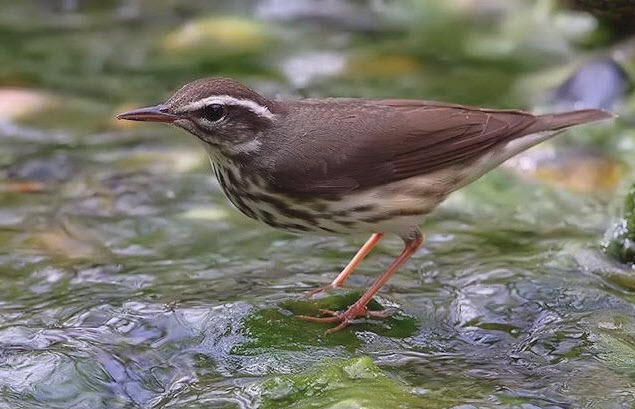
This lovely image of a Louisiana Waterthrush standing in a rushing stream shows many of the fine details needed to separate it from the closely related Northern Waterthrush. Both of these wood warblers migrate through our area in the spring and again in fall. Notice the broad white eyebrow, the unstriped throat, and the bubblegum-pink legs (only in spring). What can’t be seen here is the distinctively different tail bobbing of the Louisiana versus the Northern Waterthrush. Linda Alley photo.
18 Mar 2016 – Which Waterthrush was that?
It is the time of year for spring’s “early birds” to show up. And no, I don’t mean robins. I mean it is time for the early migrating bird species to begin moving through our area. These are typically species that don’t stay here to breed but head north to the forests and woodlands of the northern parts of the continent. In particular, these are the wood-warblers.
So I was not too surprised when I saw a Black-and-White Warbler and a waterthrush this week. The Black-and-White was working the main limbs of a huisache. The waterthrush was walking along the muddy edge of our pond.
But which waterthrush was it? There are two species of waterthrushes. They are small, brownish-backed warblers that are usually seen on the ground and near water. The breasts of both species are speckled, rather like true thrushes. They feed on insects at the edges of ponds and small streams. (Hence the name waterthrush.) The differences in their appearances are subtle. One has a broader, white, superciliary line that extends well behind the eye while the other’s “eyebrow” is less pronounced. One has fine dark spots on its throat, while the other’s throat is pure white (usually!) One has “bubble-gum pink” legs while the other’s legs are not so bright a pink.
My first thought was Louisiana Waterthrush. Its superciliary line was bold, and it extended back beyond its eye. Its throat appeared unmarked, as far as I could tell from the quick frontal view I had. It walked a few paces in the mud then hopped up on a very low limb. It had pinkish legs, yes, but the pink of bubble gum? I wasn’t sure about that and besides don’t birds’ legs get muddy? As I watched the bird it bobbed its tail in a deep bob, appeared to almost lose its balance, then recovered and bobbed again. It was a very enthusiastic bobbing. Then it flew off behind some tall reeds.
However, when I tried to enter the sighting into eBird’s database later, there was no Louisiana Waterthrush on the list of warblers possible here at this time of year. The other waterthrush, the Northern Waterthrush, was on the list. I was flabbergasted. Did I misidentify this species?
Normally, I would have gone back for a second look, but it was dark and the bird most probably long gone. So instead I thought through my observations again. Was there a yellowish cast to the white of the undersides or the superciliary line? No, I remembered a clean white. Was the chin marked with streaks, even a little? I could not recall. Did the birds’ legs almost glow “hot pink?” No they were just pink, somewhat the color of the inside of a cat’s mouth. Was it doing a “full body bob” or just a series of discreet dips? I thought back and realized it was doing an enthusiastic deep dip of the tail with a slightly sideways arc upwards.
The reference books I consulted said that the colors and markings were not definitive, unless the legs were bright pink. Bright pink legs would have indicated a Louisiana Waterthrush. The field guides said that two characteristics were considered helpful, even definitive: call note and the aggressiveness of the tail bobbing. Well, the bird didn’t make a peep, not even once. Besides, could I tell the difference between a “chink” (the Northern) and a “chik” (the Louisiana)? But that bobbing was distinctive: an almost circular motion. I concluded that this warbler was most likely a Louisiana Waterthrush.
This meant I was going against the bird gurus at Cornell. The possibilities list did not include the Louisiana Waterthrush for our neck of the woods in March. However, when I checked the nearby coastal bend areas’ lists, it was on them. I suspect that eBird data for our area are incomplete. The Brush Country is not nearly as heavily birded as the coast, so lack of sightings may have led the gurus to omit the Louisiana Waterthrush.
In The Bird Life of Texas (1972), Oberholser states that the waterthrushes migrate through at different times. The Louisiana is the early migrant, from late March to late April with March 6th being the earliest sighting. Northerns come through later, usually mid-April to mid-May. Still, the earliest Northern Waterthrush date is March 14th. Uh-oh.
In Peterson’s Field Guide to the Warblers of North America (1997), the authors describe the arrival of Northern Waterthrush: “The first spring migrants are typically noted in the South in early April; a few may appear in very late March, but the situation is clouded by overwintering birds as well as confusion with the Louisiana Waterthrush, a much earlier migrant.” The two species (Seiurus motacilla and Seiurus noveboracensis) are members of the same genus and are sometimes collectively called “water wagtails.” Confusion between the two is bound to occur.
These two terrestrial waterside warblers with the plain brown backs and the tail-bobbing habit are just hard to identify. All in all, I think the bird I saw was a Louisiana Waterthrush. That’s my story and I am sticking to it!
If you would like to offer comments, please click through to the discussion page
